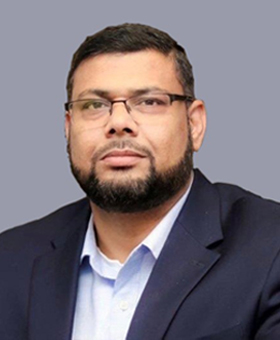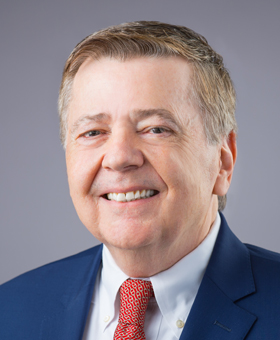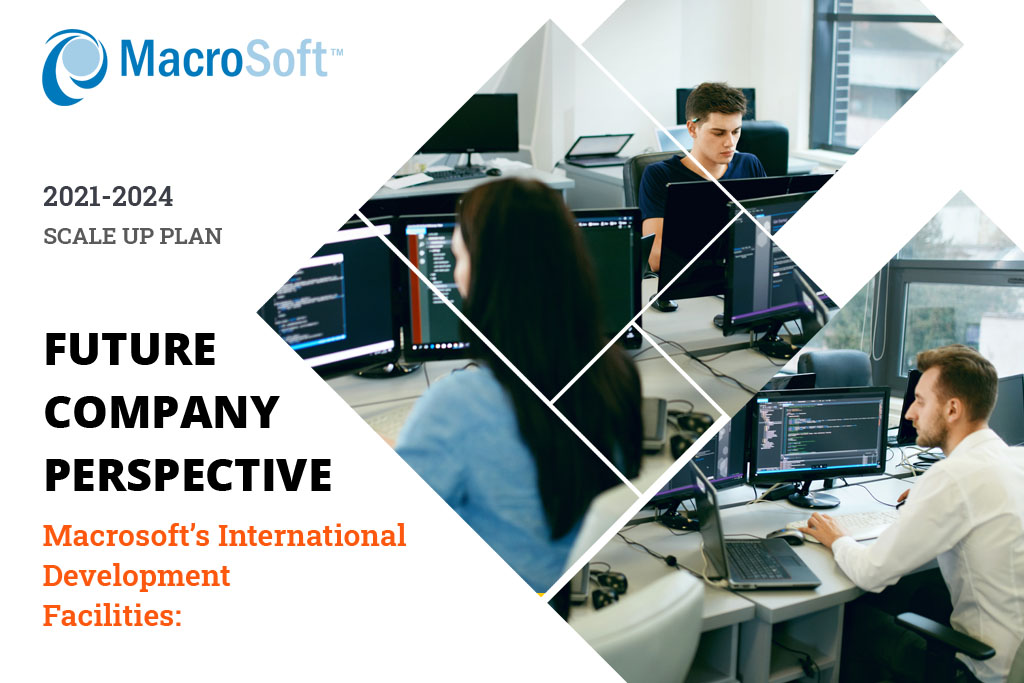

This is the first in a series of papers on future directions of Macrosoft – how we are planning to build up our company in scale, resiliency, flexibility, responsiveness, and sustainability. Most importantly of all, we are focused on how to retain our top-level talent, and to sustain and enhance the life-balance and career growth of every member of our company. The time frame for these views is the 5-year period from 2020-2024, and thus includes the pandemic period we are now living thru, and a possible post-pandemic world to come at some point in the future.
We have been sparked to write this paper and the others in this series by several pivotal articles in recent issues of the Harvard Business Review. We cite them below as background for what is driving our thinking and strategizing about our company.
Obviously, the business, economic, and social world has and continues to go thru upheavals as we write this article, and there is no reason to think these disruptions will slow down or that we will go back to the old normal. In our humble view, that is not even a remote possibility. So, it behooves every leader of a company to spend more time than ever on the future needs and directions of their company. That is the focus of this series of papers.
For us, these writings are real and represent all our latest thinking on the directions we intend for our company. Every day we will implement these strategies for Macrosoft, and as necessary, will modify and update these strategies as the world continues to change in unexpected ways.
This first paper concerns our two international development centers, and how we see them scaling up over this 5-year period. They are an integral part of our company, essential to the full execution of our work in all 6 of Macrosoft’s lines of businesses. As we describe below, we see them both as major engines of growth for our company. But the path to this future is full of potential potholes and we describe in this paper our strategies for meeting each of these challenges.
Harvard Business Review Articles:
- “Future-Proofing Your Organization”, Prepare your team to stay ahead in the post-pandemic world; Michael Mankins, Eric Garton, and Dan Schwartz, all Bain Partners; Sept-Oct 2021.
- “How Good Is Your Company at Change?”, David Michel’s, Kevin Murphy, both Bain Partners; July-August 2021.
Introduction
Macrosoft has two excellent development facilities, one in Lahore Pakistan and the other in Trivandrum India. Both have been key parts of Macrosoft for well over a decade. ‘Mac Pak’ is currently (mid-year 2021) around 150 technical staff, and ‘Mac India’ is about 100.[1] Both are slated to grow by at least 50% this year. We project Mac Pak to end the year at 175 members and Mac India at 125 staff.
We are targeting to significantly scale up both facilities over the next three years (’21 – ‘24) to reach at least 500 staff members in each. We show below yearly projections of staff count in each center by type of work. This paper also lays out the main elements of our strategy to make this happen.
Both centers do outstanding technical work adhering to best practices including ISO 9001 standards. Both centers include senior world class level talent who have been with us for many years, and many mid- and junior-level talent that are managed closely by the senior level talent. We also have campus programs (so far centered mainly in Mac India) where we train entry level technical talent (BS and/or MS degrees) in several of the core technologies that underpin our lines of business. Both centers have completed dozens of complex enterprise projects with distinction for our US client base. We have the references and referrals to prove it!
Of course, the members of both centers have been working remotely since April of 2020, and we expect this to continue for the foreseeable future. We have been able to achieve a level of productivity and quality at least as high as before we started the remote work environment. In fact, over this second year of remote work we are planning for further increases in team productivities and quality, exceeding pre-pandemic levels, while at the same time having all members maintain a reasonable and balanced work-life mix.
Part of our strategy for scaling up these two centers hinges on implementing a hybrid work model for the long run, one where even when it is safe and normal to return to the office, we will be offering most members the option to work primarily remotely from home with periodic/occasional office visits for: team conferences and coordination; training sessions and campus programs; company meetings, and perhaps most importantly brainstorming and new product development meetings. This hybrid work strategy greatly simplifies scale-up since office space and related environments will not need to scale linearly with employee counts.
In this paper we describe the areas of work that are common to both facilities as well as the specialization areas for each of these facilities. Together, the two facilities support all six of Macrosoft’s lines of business. Over the last year, we have been enhancing both centers, so they have all they need to scale significantly over the next several years. A prime purpose of this paper is to describe our strategy for this anticipated scale-up.
With this paper we are also making it known to our clients and prospects to contact us if they are interested to be a specific part of this scale up. We are ready to work with several new partners to incorporate their needs and requirements in the scale up, and we would also be receptive to pursuing a BOT [2] strategy for some of our partner clients. There will be several more papers to be published this year that will lay out in detail our approach to teaming up with a client for a BOT implementation.
Next sections of this paper include:
- Description of key factors that underlie success of our international dev. centers
- Brief description of our international delivery model
- Technical and business process concentrations of each center
- Projects of member counts by center and by type of work over the period 2021-2024
- Strategies and tactics we will use to facilitate expansion of each center
- How BOT fits into this strategic view
Our two international centers are tremendous assets for our company, and we are ready and prepared to build upon our extensive knowledge and experience in continuing to successfully run these centers and to expand them greatly, both for our internal expansion needs as well as possibly that of some of our clients.
Hybrid Work Environment
As noted above, we are currently during a near-total remote-work environment for all staff in both international development centers (as well as our US HQ location). At a minimum, we expect this to hold for at least another 6 possibly 12 more months. What will happen after that assuming the pandemic comes under control? Our view is, to a large extend, that depends on the type of business and the preparations made by the company to accomplish a successful remote work environment.
For Macrosoft, a company focused primarily on technology services including enterprise development, it is 100% clear to us that a remote-work environment can work well and be highly successful. We have shown that to be the case for our company. It is clear to us that we can continue in this mode indefinitely. Moreover, we want to excel at this remote-work model. This model enables us to hire good talent from anywhere in India and Pakistan.
We are currently doing much more than just stay in place…we are implementing a myriad of enhancements in processes and communications and management processes (as well as all other business functions) to further enhance our remote-work environment, to make us into a truly distributed enterprise. The goal is to better network together everyone in the company and ensure that all project team members are fully synchronized in their work environments.
Our work is also intended to make Macrosoft more resilient and flexible to further unexpected changes and ready to take on a fully remote work environment while at the same time remaining a totally cohesive and integrated company. These views and goals we now hold are consistent with the best practices laid out in the recent business literature. We have paid special attention to the best practices laid out in two recent articles from the Harvard Business Review. We refer readers to these two articles shown in the preface section.
Our work also includes extending our proactive interactions and communications channels with all our clients. We summarize the things we have done and are now doing in this regard in a later section of this paper. With these enhancements, we expect our remote-work environment to continue to get better in terms of productivity as well as the engineered quality of our work. We do not expect this to ever end, we are convinced that we will need to remain acutely attentive to abrupt and tidal changes as they may occur in the macro-economic world.
Also, a key part of our thinking concerns the well-being and vital interests of all our team members? Not surprisingly, for most part, our informal surveys have indicated that, given current pandemic circumstances, essentially all team members are fully in favor of continuing the remote-work environment.
When and if things get back to some sense of normal, and risks of meeting in person in the office are low, we anticipate there will be interest in pursing a hybrid work environment, where team members spend some time in the office, perhaps 1-2 days per week on average. So, we are planning for an office environment capable to support 20-40% of the work force at any given moment. We do not ever expect to go back to a full 100% office environment. We believe most employees are happy with the work time they spend at home.
Also, it is important to recognize that our company has three geographically dispersed locations, and projects are normally composed of members from more than one of these locations. So, as a general course, our teams are required to work together remotely through all phases of our projects and given the high levels of communication processes we have established throughout the company this is just not a big problem for us.
The main purposes we can see for having in-person team meetings at our three centers include the following clear purposes:
| Team meetings | Project team meetings Review details and quality of coding and architecture Map out business requirements |
| New Products | New product meetings Design Thinking |
| Brainstorming | Brainstorm sessions on new technologies and products Future tools and technology stack adoptions by company |
| Training | Training sessions on new technologies Macrosoft Campus program |
| Company Social Mtgs. | Company-wide social gatherings Solicit employee inputs Social gatherings for people to meet and get to each other |
| Work from Office | Office work for individuals who just do not feel comfortable with full-time homework for any number of reasons |
We fully recognize these purposes as useful and effective to the smooth running of the company, and especially for fostering our growth over the next few years. So, our strategic view is to plan for a level of average-day office usage of 20-40% of the member population.
This is our view of the hybrid work environment for the future state of our company post-pandemic. At 20% usage we already have enough office space currently to meet our goal of 500 people for each international center by 2024. We consider this a big plus in our planning for future growth.
International Development Centers
The chart below profiles that main common characteristics and processes that define the operation of our two international development centers. Both facilities have been part of Macrosoft for over a decade, and during that period we have honed down all the factors that make them highly productive and valuable parts of our company. As you’ll see in the next section, they contribute significantly to all 6 lines of business of our company.
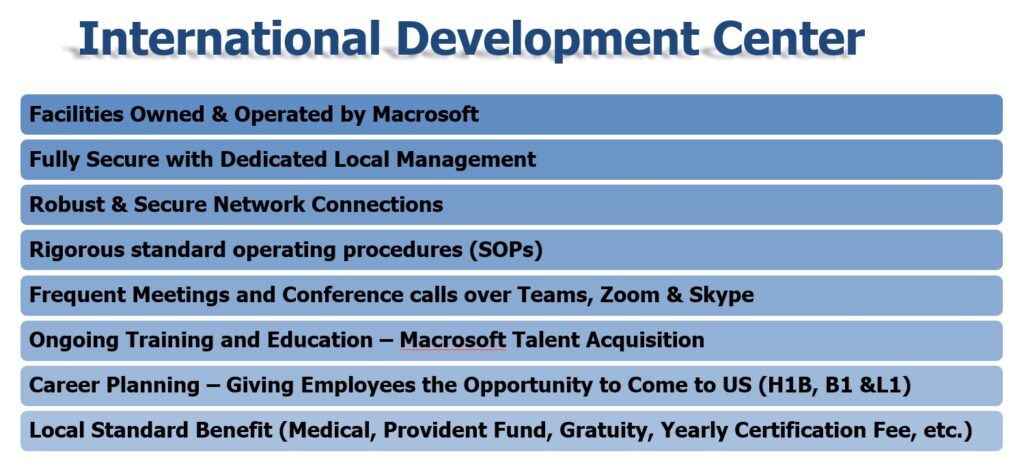
The chart below is a schematic showing the basic points of our international delivery model. Both development centers do work only for clients managed out of Macrosoft’s US HQ location. Over 90% of our work is for US companies. The other 10% of the work is for companies in other parts of the world, but that work is managed, and contracts are written with Macrosoft’s US HQ’s. and we specifically do not do work for companies or other entities inside either India or Pakistan.
In about 50% of our projects currently there is a US project manager/tech leader that works closely with the client manager and technical staff. For each project, most all development team members and a local tech leader will be located out of one of our international centers. That is the first of our two normal work process models. The other model, with about 50% of current projects, is one in which the entire team, including our client facing PM and technical manager work out of our international center. We are planning for this model to continue to grow over the next few years to encompass a greater percentage of our new projects.
Most sales and tech consulting during sales is done out of the US location, although starting this year we have begun to add sales consultants at our international facilities as well to support our US sales team. We expect this placement of sales support people at our international locations to grow dramatically over the coming years.
International Development Model
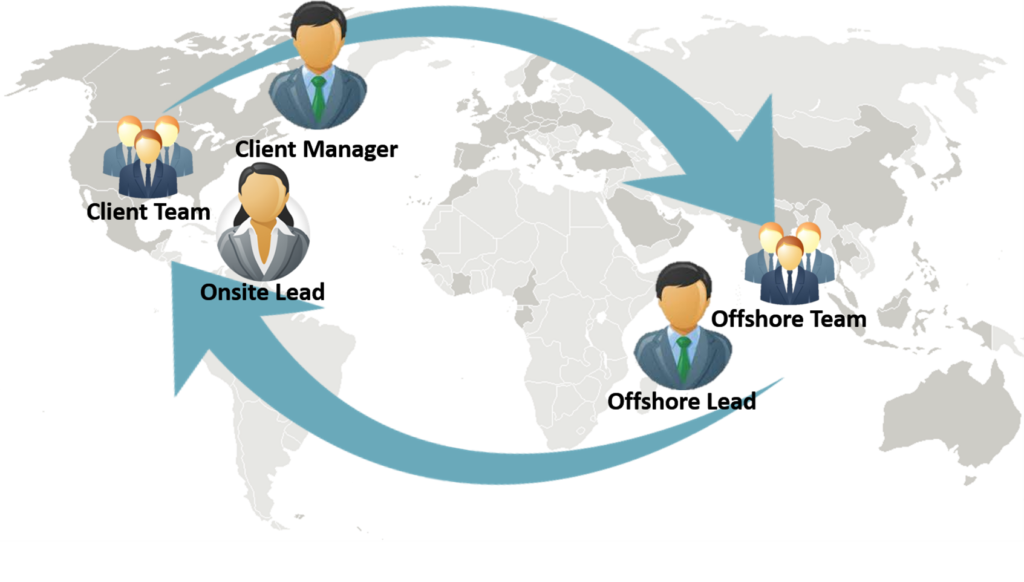

One of the key strategies for the coming years is to expand our sales efforts to Europe as well as to areas of the Gulf States. As this happens, we are planning for more of the full sales cycle to take place directly out of our two international centers. We are expecting for significant growth in the US also, but the balance of our work internationally is projected to increase to ~20-30% of the total by 2024.
New International Center?
One idea we are currently considering is setting up a 3rd international center, one that is purpose-built to start out and remain entirely remote and virtual – a truely distributed enterprise from day one. One of the major advantages of the current remote work environment across our industry is the fact that now we can recruit good talent from anywhere within the countries we are active in. There is no need for them to be local to our facilities or be willing to re-locate. If we can truly manage a remote work force, which we most definitely can, then we can recruit people from anywhere in India and Pakistan. For example, in Pakistan we can now recruit the most talented people who are living in other major Pakistani cities other than Lahore.
In fact, we are already broadening our sights beyond those two countries to include others: Eastern Europe; Turkey; Canada. We already have close network ties to Turkey thru several of the senior members of the Macrosoft US team as well as thru partner companies.
Rather than just bringing on single people here and there into this new center, we are considering establishing teams of people within the same region. There are lots of things we need to still consider and work out, but the basic fact is now staring us straight in the face: that the market for good talent has now broadened to include all-country possibilities and soon enough may be all-global. The largest outsource companies in India for example are now pursuing this all-country strategy intensely, and we either get on board pursuing this strategy or expect to lose out on the best talent to them.
In addition to searching and finding talent on a country-wide basis, we are also pursuing all sorts of measures to control the other side of this equation, namely, to keep our people stable and in place. We recognize that the new world order in countries like India will intensely increase competition for our best talent, and we are pursuing a multi-pronged approach to keep most of our best talent in place. We will have much more to say about this point in a later paper.
Lines of Business at Each Int’l Center
This section lays out the main technical capabilities of each development center and how each capability fits within one of Macrosoft 6 lines of business. The chart below highlights the 6 main lines of business Macrosoft is now pursuing. As noted earlier our international centers pursue common work areas as well as each has several areas of specializations.
In the small table below, we lay out the main areas each international center is now concentrated on. In the next section we then show projections of member counts we are planning for each area of work and for each center.
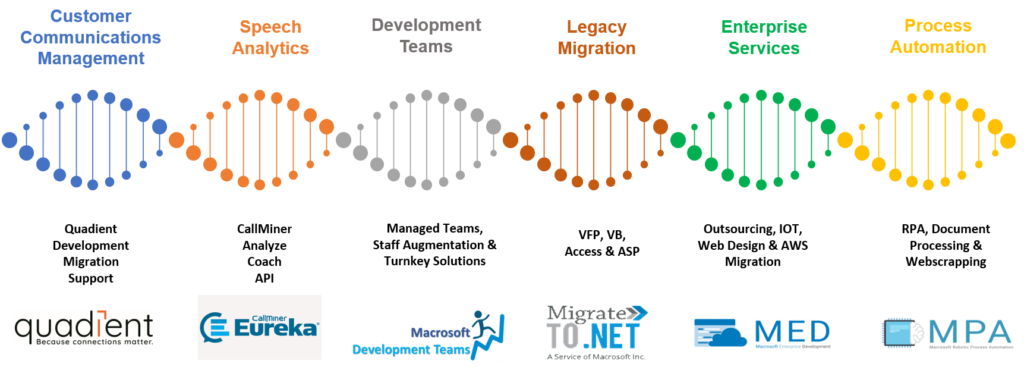

| Mac India | Development Teams, CCM/Quadient, Enterprise Development, Process Automation |
| Mac Pak | Legacy Migration, Enterprise Development, NLP/Call Miner, Process Automation |
Projected Growth of Two Centers
In the table below we show the member counts for the main areas of work for each center today (2021) and what we are planning over the next several years. As we scale up each area of work, our strategy will be to diversify the teams more completely across the two locations. The chart shows member counts for each area of work over the years of the projection.
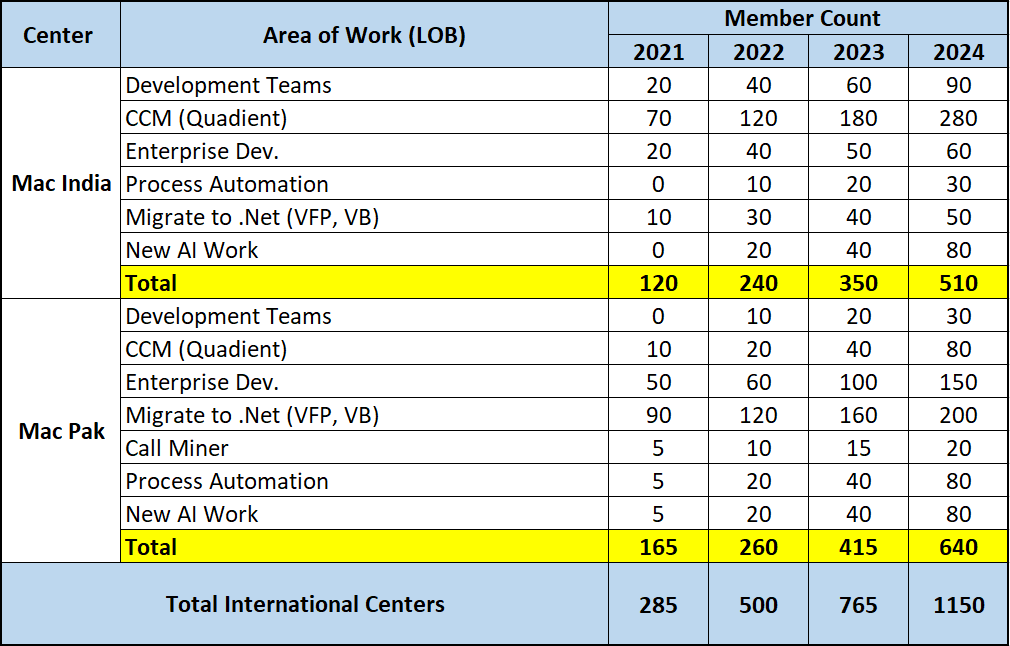

Macrosoft Campus Program
One of the central ways we expect to grow and meet these member counts for future years is through our Campus program. The chart below shows the main features of our campus program. The program was started about 3 years ago and has become a tremendous success both at our international centers as well as in our US location.
In another paper to come out soon we will describe our campus program in detail, including all the steps we follow to continue the training of our teams after the formal training period is done. As a rule, the formal training program is about 4 months in duration and then the graduates become members of our project teams and are watched over very closely to make sure they gain the proper industrial experience for at least one additional year.
The current campus program has been and will continue to be the main vehicle for our growth in the Quadient LOB, both in US and at our Mac India facility. We expect 70-80% of the member counts shown in the projection table above for the Quadient LOB to be people who come through our campus program. There is simply not enough accessible talent in the Quadient specialization for us to successfully recruit into, and moreover, at the end of their training programs our campus graduates are generally way more expert at many of the newer pieces of the Quadient technology family. So, for Quadient, our Campus program will do most of the heavy lifting, and so far it has worked out tremendously well.
- Giving Young Students Professional Environment to learn modern technology tools and languages
- Mentor by Professionals
- Access to Paid Courses and Certification portals.
- Opportunity to work on Complex Projects
- H1B Sponsorship
- Placement at client side with Market rate Salary
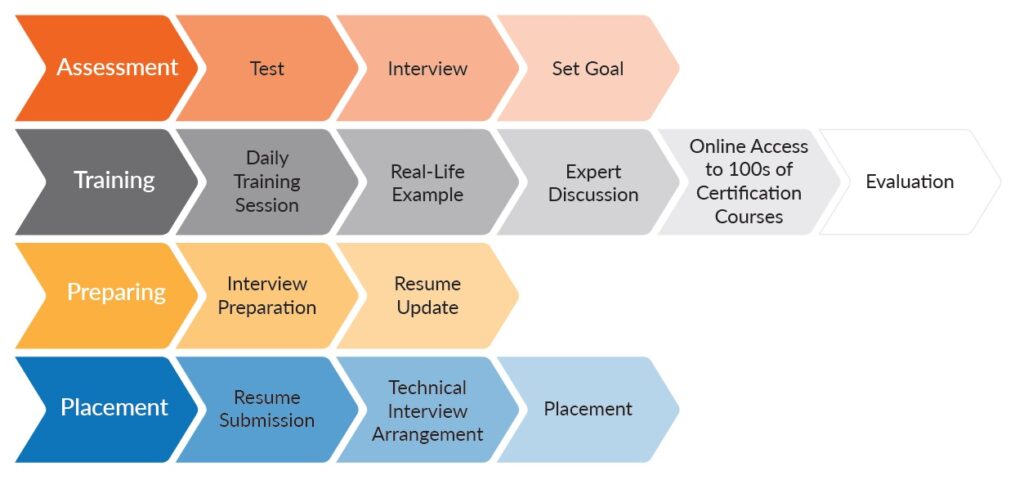

We are now planning to extend the Campus Program to other technology areas, as shown in the list below.
| Work Area | Description |
| Legacy Migration | We expect training programs to become a key part of our expansion of work in the Legacy Migration LOB. The training will be across the roughly 10 products we have in the area now. It will also include training in some of the new legacy migration areas we are now building automation tools for, including VB migration; Java to Python; Tableau to Power BI. |
| Call Miner | In the Call Miner LOB, we have already had a Call Miner-sponsored training program for 4 staff, and we see more of that in the near future. But we are also planning to engage in Macrosoft campus training for Call Miner to reach the numbers shown in the table above. |
| Process Automation | The same approach will be followed for our Process Automation LOB, where we will use a mix of technology company-sponsored training combined with our campus program to train our teams on at least two technology platforms at the center of the process automation area, Celonis and UiPath. |
BOT Implementation
So where does BOT implementation fit into the strategic picture painted above? Our view is the following. We are now engaged in a major 3+ year expansion of our two international centers. At the end of this expansion, we are anticipating a total of over 1000 members across the two locations.
As part of this expansion strategy, we would be happy to engage some of our customers in a plan to include one or multiple teams for a particular client. Obviously, we will be engaged deeply in all aspects of the build and operate portions of BOT in the process of our scaling up. As part of that scaling-up we can include client teams as well. So, the first two elements of BOT – Build and Operate – are already incorporated into our scale-up strategy. Once a client’s teams are assembled and operating well, we would be happy to work with the client on an approach to Transfer.
One way or the other, whether clients engage us in a BOT approach or not, we will be scaling up our two international centers dramatically over the next 3 years, and in the end these resources will be utilized to meet new client requirements and projects. So, either way the net result will be the same in the sense that these new expanded resources will be working for our client base.
From a risk-benefit point of view we would like to have some BOT arrangements with our clients in place up front to lessen the risks to us of this sharp expansion strategy. And obviously this expansion strategy is subject to change as we see the early results. it may be toned down somewhat or more hopefully will be expanded even faster depending on the early results.
Final Comments
In this paper we provided projections of member counts at our two international development centers. Obviously, these growth targets are quite high, and should be viewed as a best-case scenario. But it is important to emphasize that these targets are not just pie in the sky estimates. We have thought long and hard how to expand the company, in particular our two international centers. There are so many valued-added benefits to our company to expand these international centers and as a result we are pinning our overall company growth on the very significant growth in these two centers. Besides the well-known and obvious cost benefits, among other major benefits these centers provide are the following:
- Tremendous pools of top-notch technical talent in both countries
- Our ability to recruit from the best universities in Pakistan, a segment of the talent pool generally not available to us in the US and to some extent not even in India
- Location of our Indian facility in the Trivandrum Technopark, which provides outstanding services and facilities
- Both governments in Pakistan and India are intensely focused on enhancing IT services for export to other countries and that has help us greatly to grow and prosper in both countries
- Good to excellent English language skills in both countries so the members of our teams can interact effectively with US PMs at Macrosoft as well as directly with our clients. As noted earlier, we see direct management of projects to evolve more to both these locations over the coming years.
- Our ability to engage in the Macrosoft Campus Program at a much lower cost point that in the US, which is a critical element to making our expansion plans work.
- We are beginning to seed sales support staff in both facilities. Over the next year we see that model expanding greatly to the point where full life cycle sales activities will be conducted successfully out of each facility, under the management direction of the US HQ staff. This is considered another critical element for achieving our growth targets.
- Both centers will be essential to meeting our ambitious growth targets in both Europe and the Gulf States. In both areas of the world, our two international centers can provide onsite support to these areas as needed for each project. In fact, we believe they can do so much more easily and cheaply that\n we can from the US, so that will be our preferred approach.
- It is much more realistic and doable to support and continue to employ teams in these two centers in cases where there are temporary slowdowns in our new work-flows or more severely if there is a major downturn in the global economy over the timeframe we are considering. So we consider these centers to be very useful from a risk management point of view.
Further papers in this series on “Future Company” will delve much more deeply into the points laid out above.
[1] These member counts include our consulting partners we work with especially in Pakistan. It also includes the member count of our training programs in Mac India.
[2] BOT: build, operate and transfer. We describe this in detail in the paper.
ByG.N. Shah, Ronald Mueller | Published on September 28th, 2021 | Last updated on July 15th, 2024 | New Technology and Trends

 Home
Home Services
Services







































